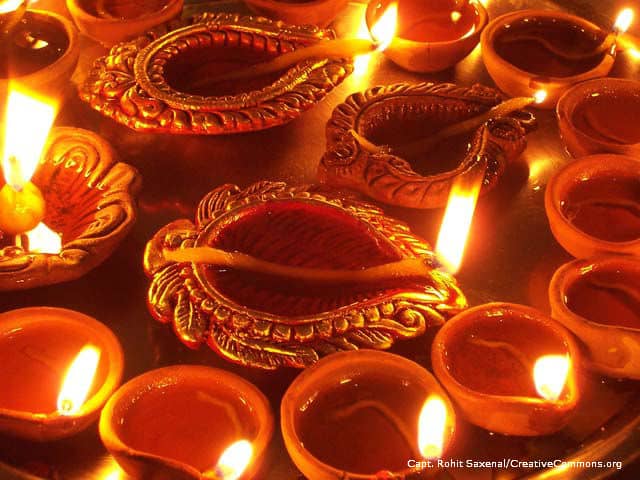When we were kids, besides praying with our family at the temple, my brother and I attended a weekly bhajan at a neighbor's house. It would end with a potluck dinner after which we kids ran around ragged and wrecked the poor host's house.
Every home had a puja room--a public display of Hindu gods. It was a prayer room and an altar, where we lit a lamp and recited Sanskrit mantras in the evening.
Hindu festivals were spectacles of light and color. For Diwali, one of the largest Hindu festivals, everyone wore new clothes, distributed homemade sweets to friends and relatives, and burst firecrackers. For Durga puja, we built floats carrying a statue of the goddess Kali. There was an informal competition to decide which neighborhood had built the best float. The atmosphere during Durga puja in Calcutta is like the carnival in Rio.
How, then, was I going to raise my daughter as a Hindu in a Christian country?
How could I even hope to duplicate the carnival-like atmosphere of Hindu festivals in America, where they are largely uncelebrated?
The simplest thing would have been to let go altogether like some of my Indian friends have done: they name their children Neil or Megan, ignore their Hindu roots, and celebrate Christmas. It is easier on the kids, they say. It creates less friction, less conflict for the children, who are going to live in America all their lives. Why burden them with a religion they neither experience nor understand?
Letting go has not come so easily to me, partly because Hinduism is the only religion I know.
I also happen to really like it. I had fun celebrating Hindu festivals, the weekly bhajan gave me memories that I carry to this day, and my family's traditions have led me to install a puja room in a cupboard in one corner of my New York apartment.
If religion is an anchor, then Hinduism gave me a sturdy one.
Deciding to raise my daughter as a Hindu was the easy part. Actually doing it will be the hard part. I called my cousin Lakshmi in Michigan, who has raised two teenage boys in this country without sacrificing Hinduism. "It was hard," she says. "What you need to do is find a community of Indians who are willing to practice Hinduism. Hold bhajans in your home. It's not against the law."
No it wasn't, and in fact, I knew Indian communities in different American cities that did just that. My sister-in-law, who is a pediatrician in Fort Myers, Florida, takes her 13-year-old daughter and nine-year-old son to a monthly bhajan held in an Episcopal church. About 50 Hindu families live in Fort Myers and most of them attend the bhajan. "It gives the children a chance to meet other Hindus and learn the Sanskrit language," my sister-in-law says. "One of the parents tells them stories from Hindu mythology. It is like Sunday school except it's not held on Sundays."
That might work for suburban Florida, but what about hectic Manhattan where the average Indian doesn't have time to run out to Kalustyan's for Indian groceries, let alone meet for a monthly bhajan?
"Order books," my cousin in Fremont, California urged. "Every time I return from India, my suitcase is filled with Hindu story books. My children know about Rama and Krishna and Ganesh and all the Hindu gods."
So I did, with a vengeance. I asked my mother to send me Amar Chitra Kathas, stories from Hindu mythology that we had read as children. Every night, as I lulled my three-year-old daughter Ranjini to sleep, I showed her pictures of Hindu gods and read stories about their exploits. I called five Hindu families and asked if they would be interested in forming a bhajan group. We could meet every month and have a potluck dinner, I said. To my surprise, everyone was interested and promised to come. It seemed that they too were grappling with raising their children as Hindus in America.
When I began playing Sanskrit mantras on our tape recorder every morning, my daughter loudly protested. She much preferred her Barney tapes and wanted to watch Teletubbies. I had to relent. The Sanskrit chants may have promoted Hinduism but even I agreed that they were hard for a three-year-old to wake up to.
Putting her to sleep was another matter altogether. Then, the rhythmic chants soothed her. I continued playing the tape after she was asleep, hoping that she would subliminally pick up some Sanskrit words.
Is it working? I'm not sure. My daughter still prefers to sing 'Twinkle Twinkle' instead of 'Hare Rama'. Every weekend, when my husband and I sit before our puja room for our weekly puja, my daughter sometimes join us. She claps her hands as we chant the mantras.
She loves wearing Indian clothes, but she doesn't know any Hindu festivals. Firecrackers are illegal in America, and building a life-size image of the goddess Kali is simply not possible in our tiny New York apartment.
And so I continue, step by step, chant by chant, toward the holy light at the end of the tunnel. One measure of comfort is the realization that thousands of Hindus in America are treading on that path along with me.

